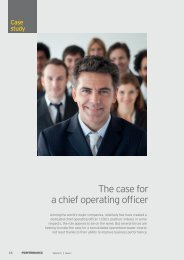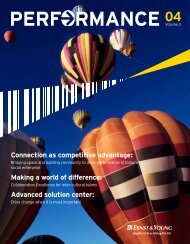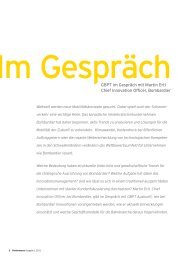Advanced Solution Center: giving stakeholders a ... - Ernst & Young
Advanced Solution Center: giving stakeholders a ... - Ernst & Young
Advanced Solution Center: giving stakeholders a ... - Ernst & Young
Create successful ePaper yourself
Turn your PDF publications into a flip-book with our unique Google optimized e-Paper software.
Case study<br />
<strong>Advanced</strong> <strong>Solution</strong> <strong>Center</strong>:<br />
<strong>giving</strong> <strong>stakeholders</strong> a voice<br />
This article examines how the <strong>Advanced</strong> <strong>Solution</strong> <strong>Center</strong> (ASC) can drive<br />
change at a faster pace. The ASC brings together key decision-makers<br />
from across an organization and allows them to create and develop better<br />
solutions to complex problems in a short time period.<br />
The economic turbulence<br />
we have seen in recent<br />
years has underlined the<br />
importance of companies<br />
having a fast and reliable<br />
decision-making process<br />
which enables them to<br />
act quickly when necessary. The ability to<br />
respond immediately, not just regarding<br />
processes and management tools but<br />
also the flexibility to adapt the business<br />
model to a rapidly changing environment<br />
becomes paramount for short- and longterm<br />
success. Driving major changes<br />
or transformation projects within your<br />
organization can be painful. However,<br />
there are ways to likely reduce that pain.<br />
Turbulent times offer the chance to<br />
outperform your competitors by taking<br />
quick, decisive action. To do this, you need<br />
the rapid buy-in and collective support<br />
of your management team so you can be<br />
confident of bringing your employees along<br />
with you.<br />
<strong>Ernst</strong> & <strong>Young</strong>’s <strong>Advanced</strong> <strong>Solution</strong> <strong>Center</strong><br />
(ASC) approach follows a particular<br />
concept, designed to increase the speed<br />
and efficiency of decision-making, change<br />
initiatives and transformation programs.<br />
It offers an effective way to bring together<br />
key decision-makers from across your<br />
organization and allow them to create<br />
and develop solutions jointly to complex<br />
challenges over the course of only a few<br />
days. Detailed preparation is vital but<br />
experience shows using the ASC can<br />
likely reduce the time needed for major<br />
transformations by up to 30%. It can also<br />
dramatically improve other factors, such as<br />
commitment and buy-in, which play a key<br />
role in every change-related initiative.<br />
Authors<br />
Christian Mertin is a Partner in the CBS<br />
Practice, <strong>Ernst</strong> & <strong>Young</strong>, India<br />
Frank Broetzmann is a Partner in the Advisory<br />
Practice, <strong>Ernst</strong> & <strong>Young</strong>, Germany<br />
Wolfgang Holzhauer is a Manager in the<br />
Advisory Practice, <strong>Ernst</strong> & <strong>Young</strong>, Germany
<strong>Advanced</strong> <strong>Solution</strong> <strong>Center</strong><br />
Common objectives realized with <strong>Advanced</strong><br />
<strong>Solution</strong> <strong>Center</strong> Events are:<br />
• Better solutions developed in a faster,<br />
more collaborative way<br />
• Stronger buy-in and commitment across<br />
the organization<br />
• Innovative strategies and solutions<br />
designed with multiple <strong>stakeholders</strong><br />
• Effective launch of new programs across<br />
the organization<br />
• Seamless communication, creating<br />
mutual understanding<br />
• Likely reduced risk, even in large and<br />
complex transformations<br />
The secret to the success of ASCs lies in<br />
the combination of proven group-based<br />
learning techniques, leading tools, fresh<br />
and focused facilitation, carefully designed<br />
creative environments and professional<br />
information design.<br />
The concept is founded on scientific<br />
principles which stimulate participants’<br />
ability to create new ideas and work<br />
together to develop innovative solutions.<br />
Each event has a customized design, with<br />
a diverse mix of individual, small group<br />
and plenary exercises, which encourage<br />
participants to think outside the box as<br />
well as reaching mutual agreement. The<br />
output from an ASC is a solution to which<br />
all participants contributed and therefore<br />
accept as their own creation. The effect<br />
is long-lasting engagement and a<br />
motivated team.<br />
Over the past few years, we have further<br />
developed our ASC concept including<br />
virtual elements and Web 2.0 technologies,<br />
turning customized event documentation<br />
websites used in earlier years into powerful<br />
transformation tools. One significant<br />
advantage is the way we make the<br />
transformation process more efficient by<br />
enabling hundreds of people across the<br />
globe to be involved in the process without<br />
incurring travel time and expenses. For<br />
example, we use crowd-sourcing platforms<br />
to actively engage large audiences in<br />
important stages of the transformation<br />
process, such as issue identification, idea<br />
generation or feedback collection. In this<br />
way, the spirit and momentum created<br />
at the initial ASC event extends and<br />
continues to provide lasting and sustainable<br />
transformation support long after the<br />
event itself.<br />
“ What most excites me is the way<br />
we are doing this all together,<br />
with people from all parts of the<br />
organization. It got every single<br />
person involved in every key aspect<br />
of the transformation.”<br />
45
Case study 1 — Developing a<br />
global finance strategy<br />
A global client and industry leader, with<br />
operations across the world, faced the<br />
challenge of globally aligning its disparate<br />
and bespoke finance organization. This<br />
included harmonizing process scope,<br />
organizational structures, target setting<br />
processes, people development and<br />
IT systems.<br />
Working with a small team from the client’s<br />
side, we developed an overarching vision<br />
and mission statement for the finance<br />
function, outlining the key principles of<br />
the future operating model for finance.<br />
The team developed three possible<br />
scenarios. Each looked at the implications<br />
for the finance functions with respect to<br />
processes, organization and governance,<br />
HR and people development, as well as IT<br />
systems. Together this formed the input for<br />
the <strong>Advanced</strong> <strong>Solution</strong> <strong>Center</strong>.<br />
" It’s different<br />
to our usual<br />
approach, there<br />
is much more<br />
involvement.<br />
This is about true<br />
ownership."<br />
“ It was the first time<br />
we had the chance<br />
to impact a strategic<br />
discussion”<br />
We brought together over 40 key<br />
decision-makers from around the globe,<br />
with representatives from all regions,<br />
business areas including shared service<br />
organizations and <strong>stakeholders</strong> from<br />
outside of finance for a two day event.<br />
After learning about the key aspects of<br />
the three scenarios, participants worked<br />
in small groups to develop their own<br />
interpretations of how the future finance<br />
operating model would function. Already<br />
on the first day, the groups presented<br />
their results to the plenary. By using<br />
our specific <strong>Advanced</strong> <strong>Solution</strong> <strong>Center</strong><br />
techniques, it became quickly apparent<br />
that the individual groups had designed<br />
almost identical solution. This meant<br />
about 80% of the new finance strategy<br />
was agreed upon right away, including an<br />
updated version of the finance vision and<br />
mission statement. Before moving on to<br />
explore further details of the strategy, a<br />
leading academic on organizational design,<br />
as well as two representatives from other<br />
leading global companies, shared their<br />
views and experiences on finance strategy.<br />
This provided the chance to hear fresh<br />
perspectives and enabled the group to<br />
challenge established practices when they<br />
met the following day.<br />
At the end of the event, the key aspects<br />
of the finance strategy centered around<br />
the operating model, including processes,<br />
organization, people and IT, was defined<br />
and agreed upon. Documentation of the<br />
results was completed and circulated to<br />
the participants just two days after the<br />
event. The results formed the basis for the<br />
detailed strategy document agreed upon by<br />
the 40 key finance decision-makers.<br />
The key benefits achieved from the ASC<br />
event included:<br />
• Agreement of the finance strategy by all<br />
major decision-makers and <strong>stakeholders</strong><br />
• Reduction in the time for alignment by<br />
about 30%<br />
• A strategy reflecting views and<br />
requirements from all regions and<br />
business areas, not just corporate<br />
headquarters
<strong>Advanced</strong> <strong>Solution</strong> <strong>Center</strong><br />
“ It is astonishing what we have<br />
achieved in just one and a half days.”<br />
Case study 2 — Rolling<br />
out a global markets and<br />
organizational strategy<br />
The client, an international leader in<br />
the professional services industry, had<br />
developed a new strategy for one of its<br />
business units. The challenge was to<br />
involve the top 500 global managers and<br />
motivate them to engage actively in the<br />
implementation of the strategy, thereby<br />
achieving a strong sense of momentum<br />
around the transformation process.<br />
To jump start the transformation process,<br />
we designed a series of ASC events<br />
around the globe to involve the 500<br />
managers in the strategy rollout. The<br />
events took place across Asia, Europe,<br />
North and South America in parallel,<br />
bringing together managers from different<br />
business areas and support functions.<br />
Working with a core team from the client’s<br />
leadership, we developed the key messages<br />
that needed to be communicated and<br />
to where input and feedback from the<br />
participants is required. With the help<br />
of designers, we applied multi-sensory<br />
learning techniques by creating, for each<br />
strategic focus area, a visual expression<br />
of the content. This made the content<br />
much more memorable than if it had<br />
been presented in a written format. By<br />
doing this, we achieved several important<br />
aspects. Firstly, it had the effect of making<br />
the participants feel this was something<br />
different right from the start. They were,<br />
more willing to contribute and to be<br />
involved. It also enabled complex issues<br />
to be communicated in a memorable and<br />
concise format. This approach and the<br />
subsequent output also provided the basis<br />
for an internal communications toolkit<br />
which could be re-used to consistently carry<br />
the message forward.<br />
All the events were structured in three<br />
successive parts. The first part was as<br />
described above focusing on understanding<br />
the strategy content with a short reflection<br />
on personal implications. The second<br />
part was about detailing certain aspects<br />
of the strategy, defining implementation<br />
requirements, and providing feedback to<br />
the central strategy team. The third part<br />
was about developing a transformation<br />
roadmap at a corporate level and also at a<br />
very personal level. In the second and third<br />
part of the events, we used techniques that<br />
enabled all participants to contribute to all<br />
aspects of the strategy while focusing on<br />
the parts that were most relevant to them.<br />
At the same time, we made sure that, at<br />
each event, a common view on every topic<br />
was reached among participants. We also<br />
aligned the content across the event series,<br />
taking key insights from one event to enrich<br />
the discussions on the following events.<br />
After the event series, we consolidated<br />
the results into one detailed document<br />
for the central strategy team. It contained<br />
the developed content on detailing and<br />
operationalizing the strategy as well as the<br />
transformation road map. The documented<br />
results formed the basis for the next stages<br />
of the transformation process.<br />
In total, the event series achieved a<br />
number of fundamental objectives. All<br />
500 participants gained a common<br />
understanding of the new strategy,<br />
provided valuable input for the rollout<br />
(detailing and operationalizing) of the<br />
strategy and its implementation, as well<br />
as creating personal action plans for<br />
everyone’s individual contribution to the<br />
transformation process. It enabled the<br />
central strategy team to refine the strategy,<br />
taking into account a more detailed<br />
regional and functional perspective,<br />
as well as setting up a transformation<br />
team and providing them with concrete<br />
and actionable tasks to turn strategy<br />
into reality.<br />
The key benefits achieved from the ASC<br />
events included:<br />
• Complete and consistent communication<br />
of the new strategy at a global level in a<br />
very short timescale<br />
• Actionable and attainable strategy,<br />
thoroughly challenged by all regions and<br />
all business areas, including regional<br />
and functional specific requirements<br />
• Great momentum for change<br />
which enabled swift and decisive<br />
follow-up actions based on the event<br />
series’ outcomes<br />
Summary<br />
The Advance <strong>Solution</strong> <strong>Center</strong><br />
methodology is versatile and can be<br />
applied to a wide range of situations.<br />
It is particularly valuable when you<br />
need the input and agreement of many<br />
<strong>stakeholders</strong> and time is a crucial factor.<br />
When it is important that you have<br />
your whole team on board and truly<br />
committed to a common goal, and you<br />
need tangible and actionable outcomes,<br />
that is when you want to use the<br />
<strong>Advanced</strong> <strong>Solution</strong> <strong>Center</strong>.<br />
47






